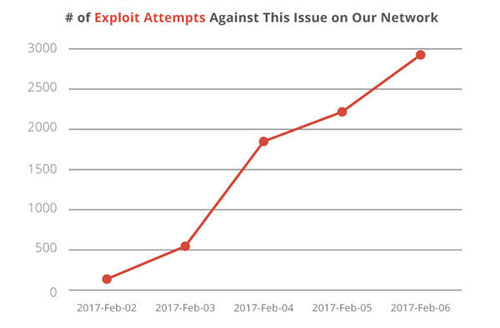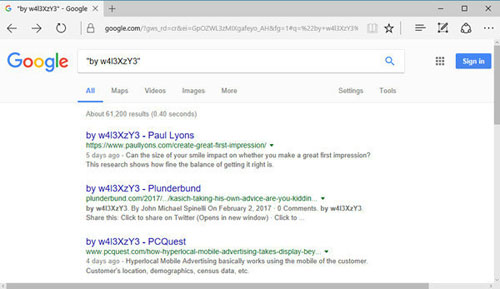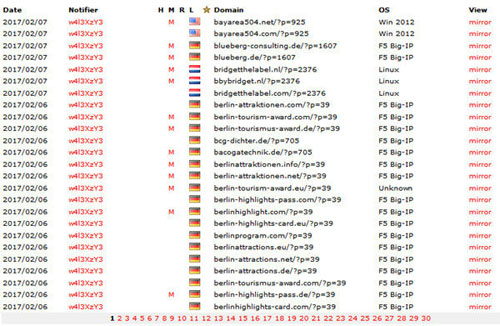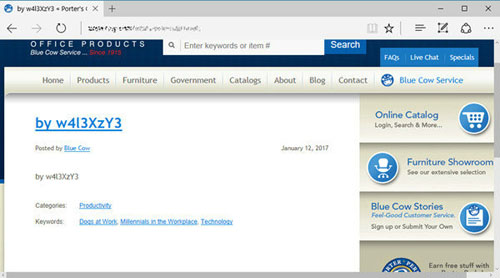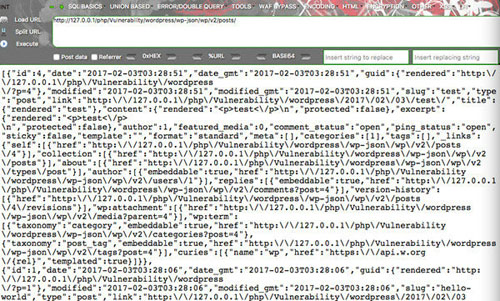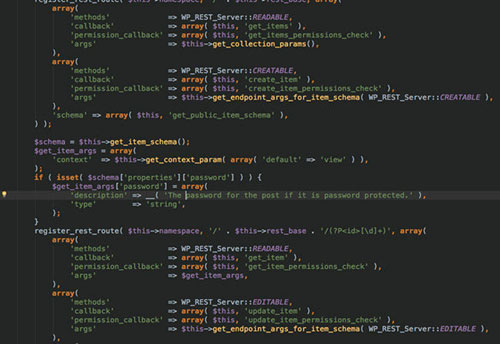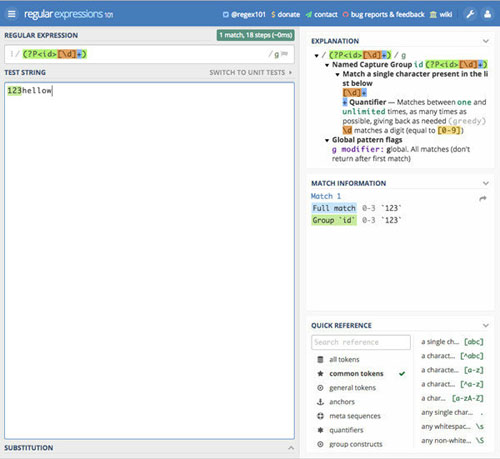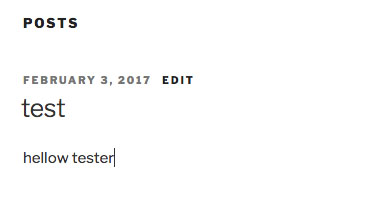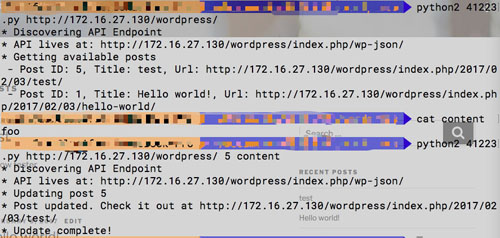Wordpress內(nèi)容注入漏洞致超67000個網(wǎng)站遭黑產(chǎn)利用
如果你的網(wǎng)站使用的是WordPress,并且沒有及時更新官方上周發(fā)布的補丁,升級到v4.7.2版本,那么你的網(wǎng)站很有可能受到這4個黑客組織的攻擊。
據(jù)國外Web安全公司Sucuri表示,自上周一該漏洞細節(jié)公開后,攻擊范圍不斷擴大,最近每天趨于3000次。
隨著時間的推移利用REST API漏洞嘗試次數(shù)(來源:Sucuri)
攻擊者正在利用WordPress的REST API的漏洞,該漏洞由WordPress團隊兩個星期前修復(fù)并更新補丁,他們于上周一公開了漏洞詳情。
攻擊者利用這個漏洞精心構(gòu)造一個向目標(biāo)站點REST API發(fā)起的HTTP請求,可以修改文章的標(biāo)題和內(nèi)容。
上周已經(jīng)有人提供了完整的利用代碼。
超過67,000的網(wǎng)站內(nèi)容已經(jīng)被篡改
即使該漏洞僅影響WordPress4.7.0和4.7.1兩個版本而且該CMS內(nèi)置有自動更新的功能,但仍然有很多網(wǎng)站沒有更新。
據(jù)Sucuri部署的蜜罐服務(wù)器收集到的數(shù)據(jù)顯示,在過去的一周,有四波攻擊者正在著手利用這個漏洞。
由于攻擊已經(jīng)持續(xù)一段時間了,谷歌已經(jīng)可以檢索一部分被攻擊的內(nèi)容。
通過Google檢索被篡改的站點
通過Google搜索"by w4l3XzY3",可以瀏覽一些受影響的站點。
部分受影響的站點列表
更多受影響站點可在http://www.zone-h.org/archive/notifier=w4l3XzY3/page=1查看。
目前,使用REST API漏洞篡改網(wǎng)站的這些組織只是做了一些知名度的曝光,將網(wǎng)站內(nèi)文章的標(biāo)題和正文修改為自己的內(nèi)容。
其中一個被篡改的站點
Sucuri's CTO, Daniel Cid表示希望看到更專業(yè)的內(nèi)容進入大家的視野,如利用該漏洞發(fā)布更復(fù)雜的內(nèi)容,黑鏈SEO:如插入鏈接和圖像。
利用漏洞做這種篡改的話,做黑鏈SEO,可以提高其他網(wǎng)站的搜索引擎排名,或者宣傳一些其他的非法產(chǎn)品。
當(dāng)然如果網(wǎng)站內(nèi)容被篡改為一些惡意內(nèi)容,會導(dǎo)致網(wǎng)站被搜索引擎屏蔽。
建議所有使用WordPress的網(wǎng)站主及時更新至最新版本v4.7.2。避免由于REST API的安全問題,導(dǎo)致網(wǎng)站被搜索引擎屏蔽。
0x00 漏洞簡述
1. 漏洞簡介
在REST API自動包含在Wordpress4.7以上的版本,WordPress REST API提供了一組易于使用的HTTP端點,可以使用戶以簡單的JSON格式訪問網(wǎng)站的數(shù)據(jù),包括用戶,帖子,分類等。檢索或更新數(shù)據(jù)與發(fā)送HTTP請求一樣簡單。上周,一個由REST API引起的影響WorePress4.7.0和4.7.1版本的漏洞被披露,該漏洞可以導(dǎo)致WordPress所有文章內(nèi)容可以未經(jīng)驗證被查看,修改,刪除,甚至創(chuàng)建新的文章,危害巨大。
2. 漏洞影響版本
WordPress4.7.0
WordPress4.7.1
0x01 漏洞復(fù)現(xiàn)
Seebug上已經(jīng)給出詳細的復(fù)現(xiàn)過程,在復(fù)現(xiàn)過程中可以使用已經(jīng)放出的POC來進行測試。
0x02 漏洞分析
其實漏洞發(fā)現(xiàn)者已經(jīng)給出了較為詳細的分析過程,接下來說說自己在參考了上面的分析后的一點想法。
WP REST API
首先來說一下REST API。
控制器
WP-API中采用了控制器概念,為表示自愿端點的類提供了標(biāo)準模式,所有資源端點都擴展WP_REST_Controller來保證其實現(xiàn)通用方法。
五種請求
之后,WP-API還有這么幾種請求(也可以想成是功能吧):
- HEAD
- GET
- POST
- PUT
- DELETE
以上表示HTTP客戶端可能對資源執(zhí)行的操作類型。
HTTP客戶端
WordPress本身在WP_HTTP類和相關(guān)函數(shù)中提供了一個HTTP客戶端。用于從另一個訪問一個WordPress站點。
資源
簡單來說,就是文章,頁面,評論等。
WP-API允許HTTP客戶端對資源執(zhí)行CRUD操作(創(chuàng)建,讀取,更新,刪除,這邊只展示和漏洞相關(guān)的部分):
GET /wp-json/wp/v2/posts獲取帖子的集合:
GET /wp-json/wp/v2/posts/1獲取一個ID為1的單獨的Post:
可以看到ID為1的文章標(biāo)題為Hello World,包括文章的路由也有。
路由
路由是用于訪問端點的“名稱”,在URL中使用(在非法情況下可控,就像這個漏洞一樣)。
例如,使用URLhttp://example.com/wp-json/wp/v2/posts/123:
路由(route)是wp/v2/posts/123,不包括wp-json,因為wp-json是API本身的基本路徑。
這個路由有三個端點:
GET觸發(fā)一個get_item方法,將post數(shù)據(jù)返回給客戶端。
PUT觸發(fā)一個update_item方法,使數(shù)據(jù)更新,并返回更新的發(fā)布數(shù)據(jù)。
DELETE觸發(fā)delete_item方法,將現(xiàn)在刪除的發(fā)布數(shù)據(jù)返回給客戶端。
靜態(tài)追蹤
知道了WP-API的路由信息以及其操作方式,可以根據(jù)其運行的思路來看一下具體實現(xiàn)的代碼。
我們看一下/wp-includes/rest-api/endpoints/class-wp-rest-post-controller.php:
根據(jù)上面的信息,我們可以知道這是注冊controller對象的路由,實現(xiàn)路由中端點方法。
在這里,如果我們向/wp-json/wp/v2/posts/1發(fā)送請求,則ID參數(shù)將被設(shè)置為1:
同時,注意一下這里:
- register_rest_route( $this->namespace, '/' . $this->rest_base . '/(?P<id>[\d]+)', array(
- array(
- 'methods' => WP_REST_Server::READABLE,
- 'callback' => array( $this, 'get_item' ),
- 'permission_callback' => array( $this, 'get_item_permissions_check' ),
- 'args' => $get_item_args,
- ),
- array(
- 'methods' => WP_REST_Server::EDITABLE,
- 'callback' => array( $this, 'update_item' ),
- 'permission_callback' => array( $this, 'update_item_permissions_check' ),
- 'args' => $this->get_endpoint_args_for_item_schema( WP_REST_Server::EDITABLE ),
- ),
- array(
- 'methods' => WP_REST_Server::DELETABLE,
- 'callback' => array( $this, 'delete_item' ),
- 'permission_callback' => array( $this, 'delete_item_permissions_check' ),
- 'args' => array(
- 'force' => array(
- 'type' => 'boolean',
- 'default' => false,
- 'description' => __( 'Whether to bypass trash and force deletion.' ),
- ),
- ),
- ),
- 'schema' => array( $this, 'get_public_item_schema' ),
- ) );
可以看到在register_rest_route中對路由進行了正則限制:
也就是防止攻擊者惡意構(gòu)造ID值,但是我們可以發(fā)現(xiàn)$_GET和$_POST值優(yōu)先于路由正則表達式生成的值:
這邊沒有找到ID為123hh的項目,所以返回rest_invalid。
現(xiàn)在我們可以忽略路由正則的限制,來傳入我們自定義的ID。
接下來在審查各個端點方法中,找到了update_item這個方法,及其權(quán)限檢查方法update_item_permissions_check:
- public function update_item_permissions_check( $request ) {
- $post = get_post( $request['id'] );
- $post_type = get_post_type_object( $this->post_type );
- if ( $post && ! $this->check_update_permission( $post ) ) {
- return new WP_Error( 'rest_cannot_edit', __( 'Sorry, you are not allowed to edit this post.' ), array( 'status' => rest_authorization_required_code() ) );
- }
- if ( ! empty( $request['author'] ) && get_current_user_id() !== $request['author'] && ! current_user_can( $post_type->cap->edit_others_posts ) ) {
- return new WP_Error( 'rest_cannot_edit_others', __( 'Sorry, you are not allowed to update posts as this user.' ), array( 'status' => rest_authorization_required_code() ) );
- }
- if ( ! empty( $request['sticky'] ) && ! current_user_can( $post_type->cap->edit_others_posts ) ) {
- return new WP_Error( 'rest_cannot_assign_sticky', __( 'Sorry, you are not allowed to make posts sticky.' ), array( 'status' => rest_authorization_required_code() ) );
- }
- if ( ! $this->check_assign_terms_permission( $request ) ) {
- return new WP_Error( 'rest_cannot_assign_term', __( 'Sorry, you are not allowed to assign the provided terms.' ), array( 'status' => rest_authorization_required_code() ) );
- }
- return true;
- }
可以看到,此函數(shù)通過檢查文章是否實際存在,以及我們的用戶是否有權(quán)限編輯這邊文章來驗證請求。但是當(dāng)我們發(fā)送一個沒有響應(yīng)文章的ID時,就可以通過權(quán)限檢查,并允許繼續(xù)執(zhí)行對update_item方法的請求。
具體到代碼,就是讓$post為空,就可以通過權(quán)限檢查,接下來跟進get_post方法中看一下:
- function get_post( $post = null, $output = OBJECT, $filter = 'raw' ) {
- if ( empty( $post ) && isset( $GLOBALS['post'] ) )
- $post = $GLOBALS['post'];
- if ( $post instanceof WP_Post ) {
- $_post = $post;
- } elseif ( is_object( $post ) ) {
- if ( empty( $post->filter ) ) {
- $_post = sanitize_post( $post, 'raw' );
- $_post = new WP_Post( $_post );
- } elseif ( 'raw' == $post->filter ) {
- $_post = new WP_Post( $post );
- } else {
- $_post = WP_Post::get_instance( $post->ID );
- }
- } else {
- $_post = WP_Post::get_instance( $post );
- }
- if ( ! $_post )
- return null;
從代碼中可以看出,它是用wp_posts中的get_instance靜態(tài)方法來獲取文章的,跟進wp_posts類,位于/wp-includes/class-wp-post.php中:
- public static function get_instance( $post_id ) {
- global $wpdb;
- if ( ! is_numeric( $post_id ) || $post_id != floor( $post_id ) || ! $post_id ) {
- return false;
- }
可以看到,當(dāng)我們傳入的ID不是全由數(shù)字字符組成的時候,就會返回false,也就是返回一個不存在的文章。從而get_post方法返回null,從而繞過update_item_permissions_check的權(quán)限檢測。
回頭再看一下可執(zhí)行方法upload_item:
- public function update_item( $request ) {
- $id = (int) $request['id'];
- $post = get_post( $id );
- if ( empty( $id ) || empty( $post->ID ) || $this->post_type !== $post->post_type ) {
- return new WP_Error( 'rest_post_invalid_id', __( 'Invalid post ID.' ), array( 'status' => 404 ) );
- }
- $post = $this->prepare_item_for_database( $request );
- if ( is_wp_error( $post ) ) {
- return $post;
- }
- // convert the post object to an array, otherwise wp_update_post will expect non-escaped input.
- $post_id = wp_update_post( wp_slash( (array) $post ), true );
在這邊將ID參數(shù)裝換為一個整數(shù),然后傳遞給get_post。而PHP類型轉(zhuǎn)換的時候回出現(xiàn)這樣的情況:
所以,也就是說,當(dāng)攻擊者發(fā)起/wp-json/wp/v2/posts/1?id=1hhh請求時,便是發(fā)起了對ID為1的文章的請求。下面為利用[exploit-db][2]上的POC來進行測試:
新建文章:
測試:
測試結(jié)果:
多想了一下
乍一看,感覺這個洞并沒有什么太大的影響,但是仔細想了一下,危害還是很大的。先不說WordPress頁面執(zhí)行php代碼的各種插件,還有相當(dāng)一部分的WordPress文章可以調(diào)用短代碼的方式來輸出特定的內(nèi)容,以及向日志中添加內(nèi)容,這是一個思路。
另一個思路就是可以進行對原來文章中的指定超鏈接進行修改,從而進行釣魚。
還有一個思路,就是利用WordPress文章中解析html以及JavaScript文件包含的做法,輔助其他方法,進行攻擊。
0x03 diff比較
對于該漏洞,關(guān)鍵的修改在/wp-includes/class-wp-post.php中:
更改了對于$post_id的參數(shù)的傳入順序和判斷條件,防止了我們傳入數(shù)字+字母這樣的格式進行繞過。
0x04 修補方案
將WordPress更新到最新版本。














